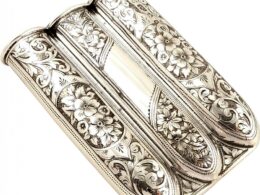By Steve Rose, research volunteer
Grade II listed and built as part of a group of houses of similar date and status on the east side of Frederick Street. From 1830s to 1860s it was primarily used a private residence, the house was owned by William Elliott (who resided in the adjoining No 25) and occupied by Miss Sarah Linwood. ‘Aged just 25, William Elliot was the manager of the family’s button works a few yards away on the corner of Regent Street and Vittoria Street’ [1]. In 1838 it was occupied by Josiah Cox Woodhill, a factor, along with his wife, two children and one servant. It was later lived in by William Elliott jnr, proprietor of the Regent Works.
Around 1860 it was acquired by Russian-born, Simeon Greenberg, a goldsmith, who seems to have been responsible for modifications to the façade coinciding with the conversion of the house to industrial use. This is confirmed by the sudden jump in the property’s rateable value from £22 to £60 in 1860. He is registered in the 1861 census living there with wife Matilda, a jewellers factor from London, son Alfred and sister Louisa, and Brother Israel (Warehouseman) and servants. During 1860s Simeon Greenberg relocated to London and Matilda remained. She was listed in the 1881 census (then as a widow) living with sons Alfred (factor) and Leopold (clerk). In the 1860s, local adverts for servants indicate some prosperity during this period.
The alterations of 1860s probably included the inscribing of the word goldsmith over the door of the side passage which became the main entrance to the rear shopping and the creation of an amply lit showroom in the area between the passage and the main entrance to the house. In 1871 the property is recorded as having an office, warehouse and shopping.
From the 1880s Alfred Sydenham, a silverware manufacturer, traded from the property and is listed in Kelly’s Directory at this address until 1921. From the 1890s regular adverts for silver cigar cases appeared in regional and local newspapers. In the publication “The Graphic” of 12 January 1918 it was noted under the section “Books about the war” that Alfred Sydenham had published “Increase British trade” (published 1914, revised 1918) on the subject of cutting so as to waste nothing and produce everything in the UK/ Great British Empire. It noted that he had 48 years of wholesale jewellery trade in Birmingham, indicating that he was an active trader since c. 1870.
In the early 20th Century, following the changes to commercial use made in the 1860s, the focus appears to have shifted for the building to be occupied by several traders, rather than being residential. Another notable trader was Fritz Kundert, originally from Switzerland. A gold watch manufacturer, he formed the Swiss company Hefick Watch in 1907 and opened a subsidiary Company at 26 Frederick Street.
A newspaper article on the theft of a number of watches, consigned to him, before they arrived at Frederick Street, in the Birmingham Post in June 1914, is evidence that he was operating from here before the outbreak of World War One. He remained registered at this address in Kelly’s Trade Directory until his death in 1936. His son, Herbert Kundert, was also in the trade. Throughout the 1920s and the 1930s, in addition to Sydenham and Kundert, several traders, including stone dealers, gem setters, metal manufacturers and engravers were registered as operating from 26 Frederick Street suggesting that the building consisted of multiple warehouses occupied by individual traders.
The residential addresses of some traders suggested that they were successful – for example Fritz Kundert is listed in the electoral role at addresses in the affluent Edgbaston area in the 1930s whilst Alfred Sydenham resided with his family in Acocks Green and Solihull. This compared favourably to the fortunes of Simeon Greenberg and his family from the 1880s. The Greenberg family had suffered hard times by the early 1880s. The Birmingham Daily Post of 18 March 1884 revealed that sons, Alfred Solomon Greenberg and Leopold Jacob Greenberg, trading as Simeon Greenberg and Sons had now moved to Mile End Road London and had filed for petition to appoint a Receiver. In Birmingham Daily Post 11 April 1884, the Receivers’ report detailed debts including over 14k owed to the bank, accrued at the time of the death of their father.
After years of neglect and abandonment, the building was bought by Mosaic Pub and Dining and renovated. Early in 2019 it opened as boutique hotel – Frederick Street Townhouse.
[1] Carl Chinn, ‘An Industrial Hive: Birmingham’s Jewellery Quarter’
Building Timeline
1825 – 30
Built as part of a group of houses of similar date and status on the east side of Frederick Street.
1830s to 1860s
Owned by William Elliot, manager of his family's button works a few yards away.
1838
In 1838 it was occupied by Josiah Cox Woodhill, a factor, along with his wife, two children and one servant.
c. 1860
Acquired by Russian-born, Simeon Greenberg, a goldsmith
1871
The property is recorded as having an office, warehouse and shopping (workshops)
1880s - c. 1921
Alfred Sydenham, a silverware manufacturer, traded from the property
c. 1907
Fritz Kundert, originally form Switzerland, forms Swiss company Hefick Watch and opens a subsidiary company at 26 Frederick Street
1920s - 1930s
Several traders, including stone dealers, gem setters, metal manufacturers and engravers were registered as operating from 26 Frederick Street
2019
Opened as boutique hotel – Frederick Street Townhouse.






